Executive Remuneration Report: CBA Financial Year 2016-2017
VerifiedAdded on 2021/04/24
|13
|2601
|43
Report
AI Summary
This report provides a comprehensive analysis of executive remuneration at the Commonwealth Bank of Australia (CBA) for the 2016-2017 financial year. It begins with an introduction to the concept of executive compensation and its significance, followed by a literature review that explores factors influencing pay levels, theoretical explanations for high pay, and the relationship between executive compensation and firm performance. The report then examines the impact of corporate governance on CEO compensation and firm performance, followed by a discussion of ethical issues surrounding executive pay in 2016, social criteria in compensation packages, and a detailed comparison of CBA's executive remuneration. Furthermore, it analyzes the changes implemented in the remuneration scheme and offers recommendations for future improvements, including greater transparency and independent oversight. The report concludes with a review of the changes and provides recommendations for future improvement.

Running head: EXECUTIVE REMUNERATION
Name of the Student
Name of the University
Author note
Name of the Student
Name of the University
Author note
Paraphrase This Document
Need a fresh take? Get an instant paraphrase of this document with our AI Paraphraser
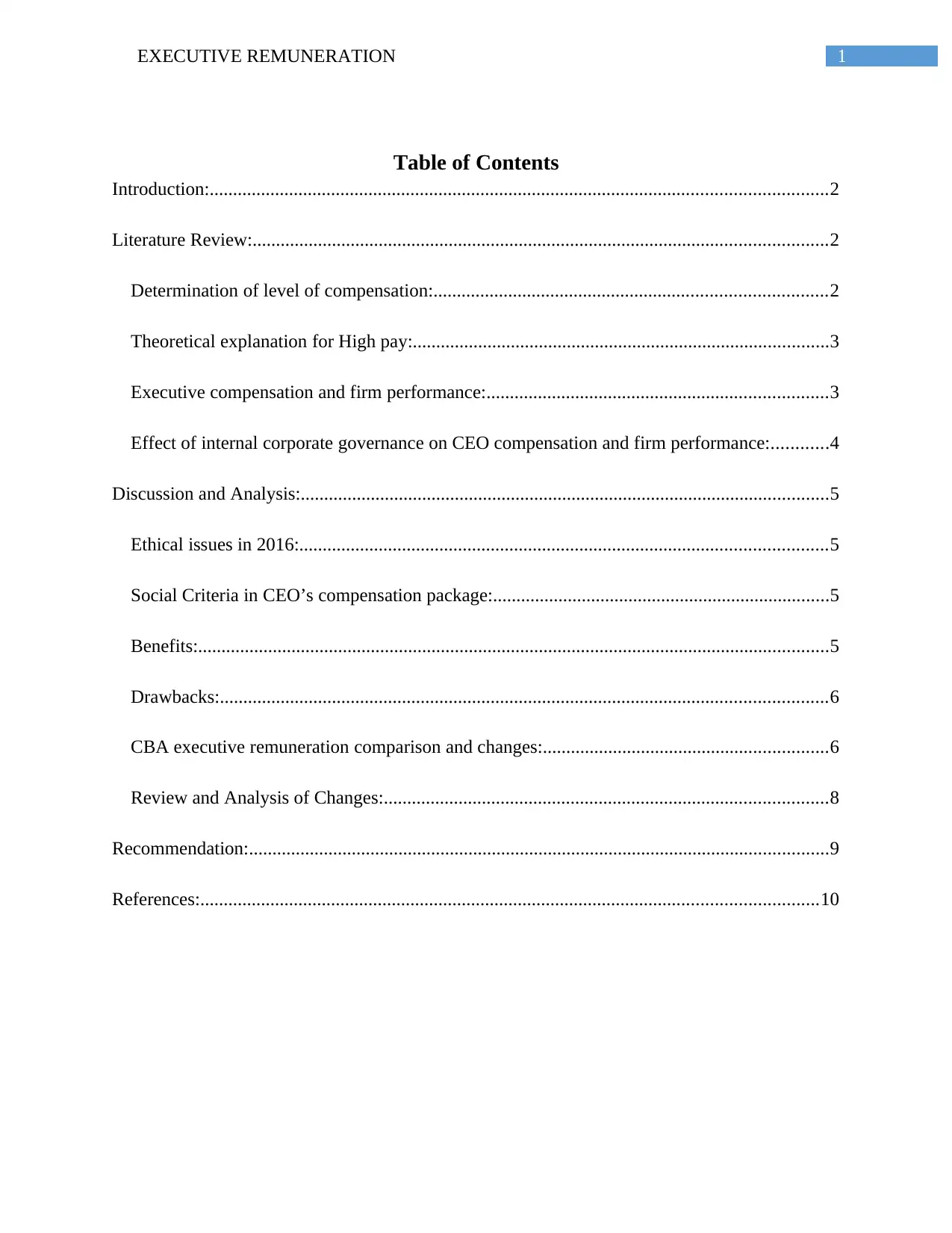
1EXECUTIVE REMUNERATION
Table of Contents
Introduction:....................................................................................................................................2
Literature Review:...........................................................................................................................2
Determination of level of compensation:....................................................................................2
Theoretical explanation for High pay:.........................................................................................3
Executive compensation and firm performance:.........................................................................3
Effect of internal corporate governance on CEO compensation and firm performance:............4
Discussion and Analysis:.................................................................................................................5
Ethical issues in 2016:.................................................................................................................5
Social Criteria in CEO’s compensation package:........................................................................5
Benefits:.......................................................................................................................................5
Drawbacks:..................................................................................................................................6
CBA executive remuneration comparison and changes:.............................................................6
Review and Analysis of Changes:...............................................................................................8
Recommendation:............................................................................................................................9
References:....................................................................................................................................10
Table of Contents
Introduction:....................................................................................................................................2
Literature Review:...........................................................................................................................2
Determination of level of compensation:....................................................................................2
Theoretical explanation for High pay:.........................................................................................3
Executive compensation and firm performance:.........................................................................3
Effect of internal corporate governance on CEO compensation and firm performance:............4
Discussion and Analysis:.................................................................................................................5
Ethical issues in 2016:.................................................................................................................5
Social Criteria in CEO’s compensation package:........................................................................5
Benefits:.......................................................................................................................................5
Drawbacks:..................................................................................................................................6
CBA executive remuneration comparison and changes:.............................................................6
Review and Analysis of Changes:...............................................................................................8
Recommendation:............................................................................................................................9
References:....................................................................................................................................10
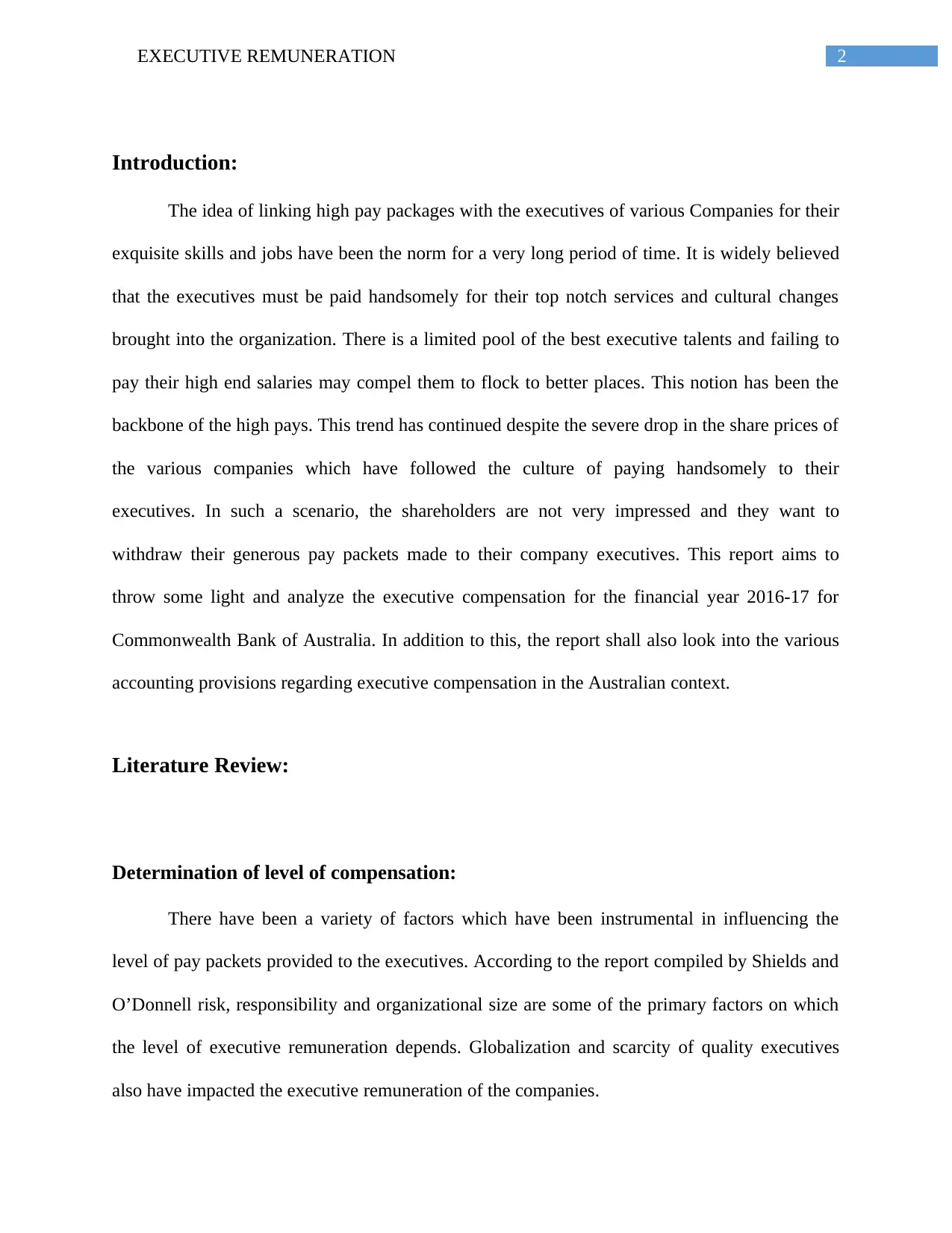
2EXECUTIVE REMUNERATION
Introduction:
The idea of linking high pay packages with the executives of various Companies for their
exquisite skills and jobs have been the norm for a very long period of time. It is widely believed
that the executives must be paid handsomely for their top notch services and cultural changes
brought into the organization. There is a limited pool of the best executive talents and failing to
pay their high end salaries may compel them to flock to better places. This notion has been the
backbone of the high pays. This trend has continued despite the severe drop in the share prices of
the various companies which have followed the culture of paying handsomely to their
executives. In such a scenario, the shareholders are not very impressed and they want to
withdraw their generous pay packets made to their company executives. This report aims to
throw some light and analyze the executive compensation for the financial year 2016-17 for
Commonwealth Bank of Australia. In addition to this, the report shall also look into the various
accounting provisions regarding executive compensation in the Australian context.
Literature Review:
Determination of level of compensation:
There have been a variety of factors which have been instrumental in influencing the
level of pay packets provided to the executives. According to the report compiled by Shields and
O’Donnell risk, responsibility and organizational size are some of the primary factors on which
the level of executive remuneration depends. Globalization and scarcity of quality executives
also have impacted the executive remuneration of the companies.
Introduction:
The idea of linking high pay packages with the executives of various Companies for their
exquisite skills and jobs have been the norm for a very long period of time. It is widely believed
that the executives must be paid handsomely for their top notch services and cultural changes
brought into the organization. There is a limited pool of the best executive talents and failing to
pay their high end salaries may compel them to flock to better places. This notion has been the
backbone of the high pays. This trend has continued despite the severe drop in the share prices of
the various companies which have followed the culture of paying handsomely to their
executives. In such a scenario, the shareholders are not very impressed and they want to
withdraw their generous pay packets made to their company executives. This report aims to
throw some light and analyze the executive compensation for the financial year 2016-17 for
Commonwealth Bank of Australia. In addition to this, the report shall also look into the various
accounting provisions regarding executive compensation in the Australian context.
Literature Review:
Determination of level of compensation:
There have been a variety of factors which have been instrumental in influencing the
level of pay packets provided to the executives. According to the report compiled by Shields and
O’Donnell risk, responsibility and organizational size are some of the primary factors on which
the level of executive remuneration depends. Globalization and scarcity of quality executives
also have impacted the executive remuneration of the companies.
⊘ This is a preview!⊘
Do you want full access?
Subscribe today to unlock all pages.

Trusted by 1+ million students worldwide
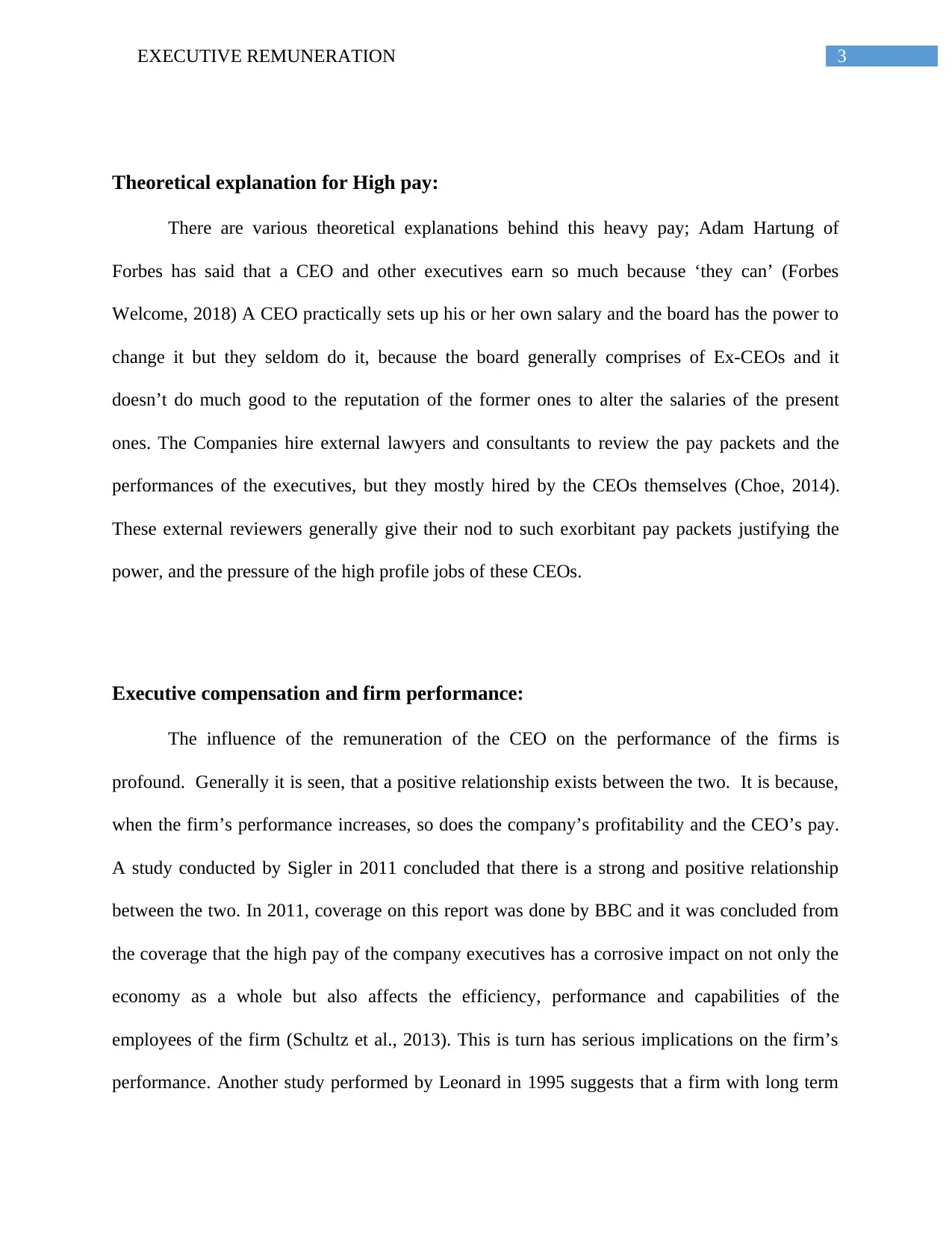
3EXECUTIVE REMUNERATION
Theoretical explanation for High pay:
There are various theoretical explanations behind this heavy pay; Adam Hartung of
Forbes has said that a CEO and other executives earn so much because ‘they can’ (Forbes
Welcome, 2018) A CEO practically sets up his or her own salary and the board has the power to
change it but they seldom do it, because the board generally comprises of Ex-CEOs and it
doesn’t do much good to the reputation of the former ones to alter the salaries of the present
ones. The Companies hire external lawyers and consultants to review the pay packets and the
performances of the executives, but they mostly hired by the CEOs themselves (Choe, 2014).
These external reviewers generally give their nod to such exorbitant pay packets justifying the
power, and the pressure of the high profile jobs of these CEOs.
Executive compensation and firm performance:
The influence of the remuneration of the CEO on the performance of the firms is
profound. Generally it is seen, that a positive relationship exists between the two. It is because,
when the firm’s performance increases, so does the company’s profitability and the CEO’s pay.
A study conducted by Sigler in 2011 concluded that there is a strong and positive relationship
between the two. In 2011, coverage on this report was done by BBC and it was concluded from
the coverage that the high pay of the company executives has a corrosive impact on not only the
economy as a whole but also affects the efficiency, performance and capabilities of the
employees of the firm (Schultz et al., 2013). This is turn has serious implications on the firm’s
performance. Another study performed by Leonard in 1995 suggests that a firm with long term
Theoretical explanation for High pay:
There are various theoretical explanations behind this heavy pay; Adam Hartung of
Forbes has said that a CEO and other executives earn so much because ‘they can’ (Forbes
Welcome, 2018) A CEO practically sets up his or her own salary and the board has the power to
change it but they seldom do it, because the board generally comprises of Ex-CEOs and it
doesn’t do much good to the reputation of the former ones to alter the salaries of the present
ones. The Companies hire external lawyers and consultants to review the pay packets and the
performances of the executives, but they mostly hired by the CEOs themselves (Choe, 2014).
These external reviewers generally give their nod to such exorbitant pay packets justifying the
power, and the pressure of the high profile jobs of these CEOs.
Executive compensation and firm performance:
The influence of the remuneration of the CEO on the performance of the firms is
profound. Generally it is seen, that a positive relationship exists between the two. It is because,
when the firm’s performance increases, so does the company’s profitability and the CEO’s pay.
A study conducted by Sigler in 2011 concluded that there is a strong and positive relationship
between the two. In 2011, coverage on this report was done by BBC and it was concluded from
the coverage that the high pay of the company executives has a corrosive impact on not only the
economy as a whole but also affects the efficiency, performance and capabilities of the
employees of the firm (Schultz et al., 2013). This is turn has serious implications on the firm’s
performance. Another study performed by Leonard in 1995 suggests that a firm with long term
Paraphrase This Document
Need a fresh take? Get an instant paraphrase of this document with our AI Paraphraser
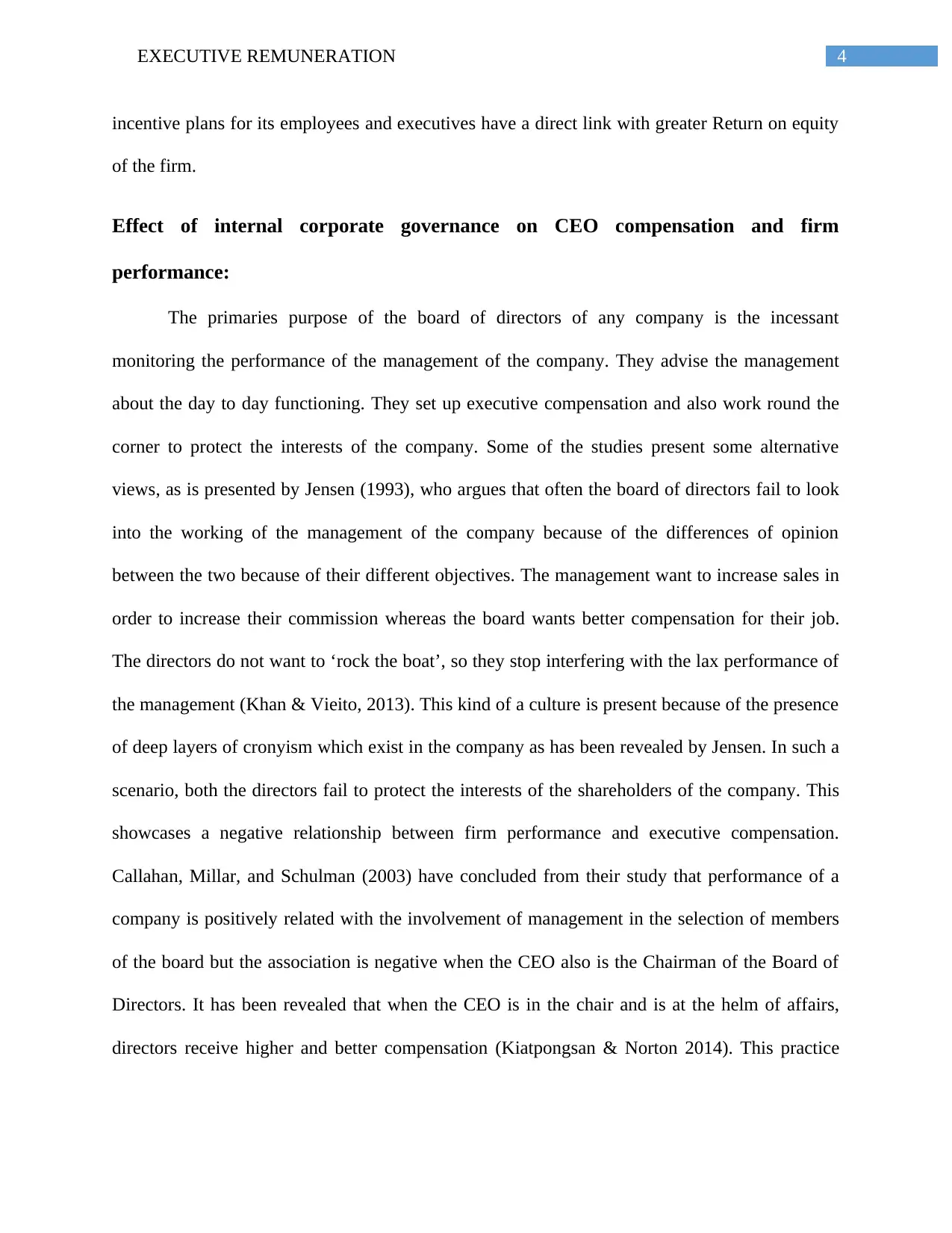
4EXECUTIVE REMUNERATION
incentive plans for its employees and executives have a direct link with greater Return on equity
of the firm.
Effect of internal corporate governance on CEO compensation and firm
performance:
The primaries purpose of the board of directors of any company is the incessant
monitoring the performance of the management of the company. They advise the management
about the day to day functioning. They set up executive compensation and also work round the
corner to protect the interests of the company. Some of the studies present some alternative
views, as is presented by Jensen (1993), who argues that often the board of directors fail to look
into the working of the management of the company because of the differences of opinion
between the two because of their different objectives. The management want to increase sales in
order to increase their commission whereas the board wants better compensation for their job.
The directors do not want to ‘rock the boat’, so they stop interfering with the lax performance of
the management (Khan & Vieito, 2013). This kind of a culture is present because of the presence
of deep layers of cronyism which exist in the company as has been revealed by Jensen. In such a
scenario, both the directors fail to protect the interests of the shareholders of the company. This
showcases a negative relationship between firm performance and executive compensation.
Callahan, Millar, and Schulman (2003) have concluded from their study that performance of a
company is positively related with the involvement of management in the selection of members
of the board but the association is negative when the CEO also is the Chairman of the Board of
Directors. It has been revealed that when the CEO is in the chair and is at the helm of affairs,
directors receive higher and better compensation (Kiatpongsan & Norton 2014). This practice
incentive plans for its employees and executives have a direct link with greater Return on equity
of the firm.
Effect of internal corporate governance on CEO compensation and firm
performance:
The primaries purpose of the board of directors of any company is the incessant
monitoring the performance of the management of the company. They advise the management
about the day to day functioning. They set up executive compensation and also work round the
corner to protect the interests of the company. Some of the studies present some alternative
views, as is presented by Jensen (1993), who argues that often the board of directors fail to look
into the working of the management of the company because of the differences of opinion
between the two because of their different objectives. The management want to increase sales in
order to increase their commission whereas the board wants better compensation for their job.
The directors do not want to ‘rock the boat’, so they stop interfering with the lax performance of
the management (Khan & Vieito, 2013). This kind of a culture is present because of the presence
of deep layers of cronyism which exist in the company as has been revealed by Jensen. In such a
scenario, both the directors fail to protect the interests of the shareholders of the company. This
showcases a negative relationship between firm performance and executive compensation.
Callahan, Millar, and Schulman (2003) have concluded from their study that performance of a
company is positively related with the involvement of management in the selection of members
of the board but the association is negative when the CEO also is the Chairman of the Board of
Directors. It has been revealed that when the CEO is in the chair and is at the helm of affairs,
directors receive higher and better compensation (Kiatpongsan & Norton 2014). This practice
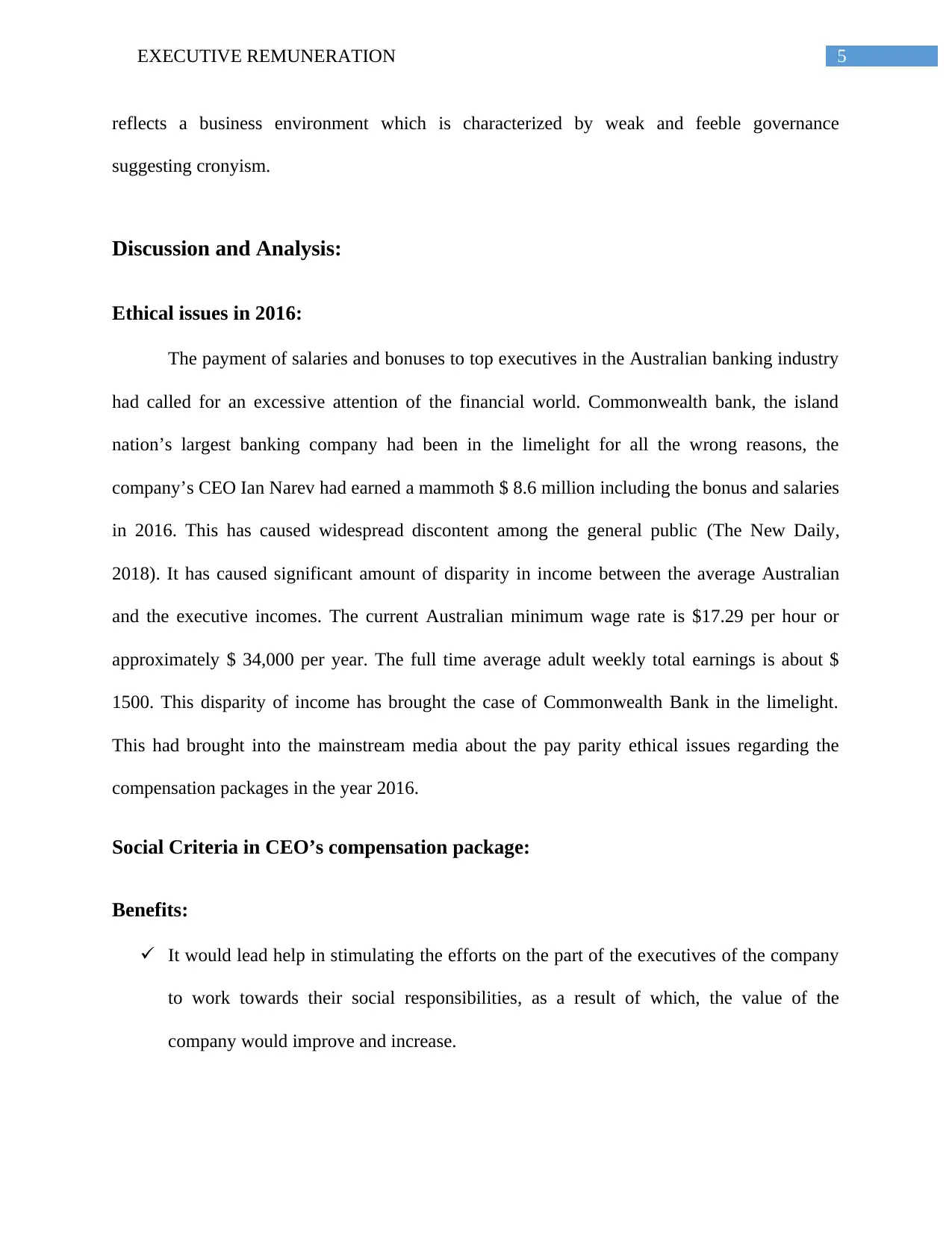
5EXECUTIVE REMUNERATION
reflects a business environment which is characterized by weak and feeble governance
suggesting cronyism.
Discussion and Analysis:
Ethical issues in 2016:
The payment of salaries and bonuses to top executives in the Australian banking industry
had called for an excessive attention of the financial world. Commonwealth bank, the island
nation’s largest banking company had been in the limelight for all the wrong reasons, the
company’s CEO Ian Narev had earned a mammoth $ 8.6 million including the bonus and salaries
in 2016. This has caused widespread discontent among the general public (The New Daily,
2018). It has caused significant amount of disparity in income between the average Australian
and the executive incomes. The current Australian minimum wage rate is $17.29 per hour or
approximately $ 34,000 per year. The full time average adult weekly total earnings is about $
1500. This disparity of income has brought the case of Commonwealth Bank in the limelight.
This had brought into the mainstream media about the pay parity ethical issues regarding the
compensation packages in the year 2016.
Social Criteria in CEO’s compensation package:
Benefits:
It would lead help in stimulating the efforts on the part of the executives of the company
to work towards their social responsibilities, as a result of which, the value of the
company would improve and increase.
reflects a business environment which is characterized by weak and feeble governance
suggesting cronyism.
Discussion and Analysis:
Ethical issues in 2016:
The payment of salaries and bonuses to top executives in the Australian banking industry
had called for an excessive attention of the financial world. Commonwealth bank, the island
nation’s largest banking company had been in the limelight for all the wrong reasons, the
company’s CEO Ian Narev had earned a mammoth $ 8.6 million including the bonus and salaries
in 2016. This has caused widespread discontent among the general public (The New Daily,
2018). It has caused significant amount of disparity in income between the average Australian
and the executive incomes. The current Australian minimum wage rate is $17.29 per hour or
approximately $ 34,000 per year. The full time average adult weekly total earnings is about $
1500. This disparity of income has brought the case of Commonwealth Bank in the limelight.
This had brought into the mainstream media about the pay parity ethical issues regarding the
compensation packages in the year 2016.
Social Criteria in CEO’s compensation package:
Benefits:
It would lead help in stimulating the efforts on the part of the executives of the company
to work towards their social responsibilities, as a result of which, the value of the
company would improve and increase.
⊘ This is a preview!⊘
Do you want full access?
Subscribe today to unlock all pages.

Trusted by 1+ million students worldwide
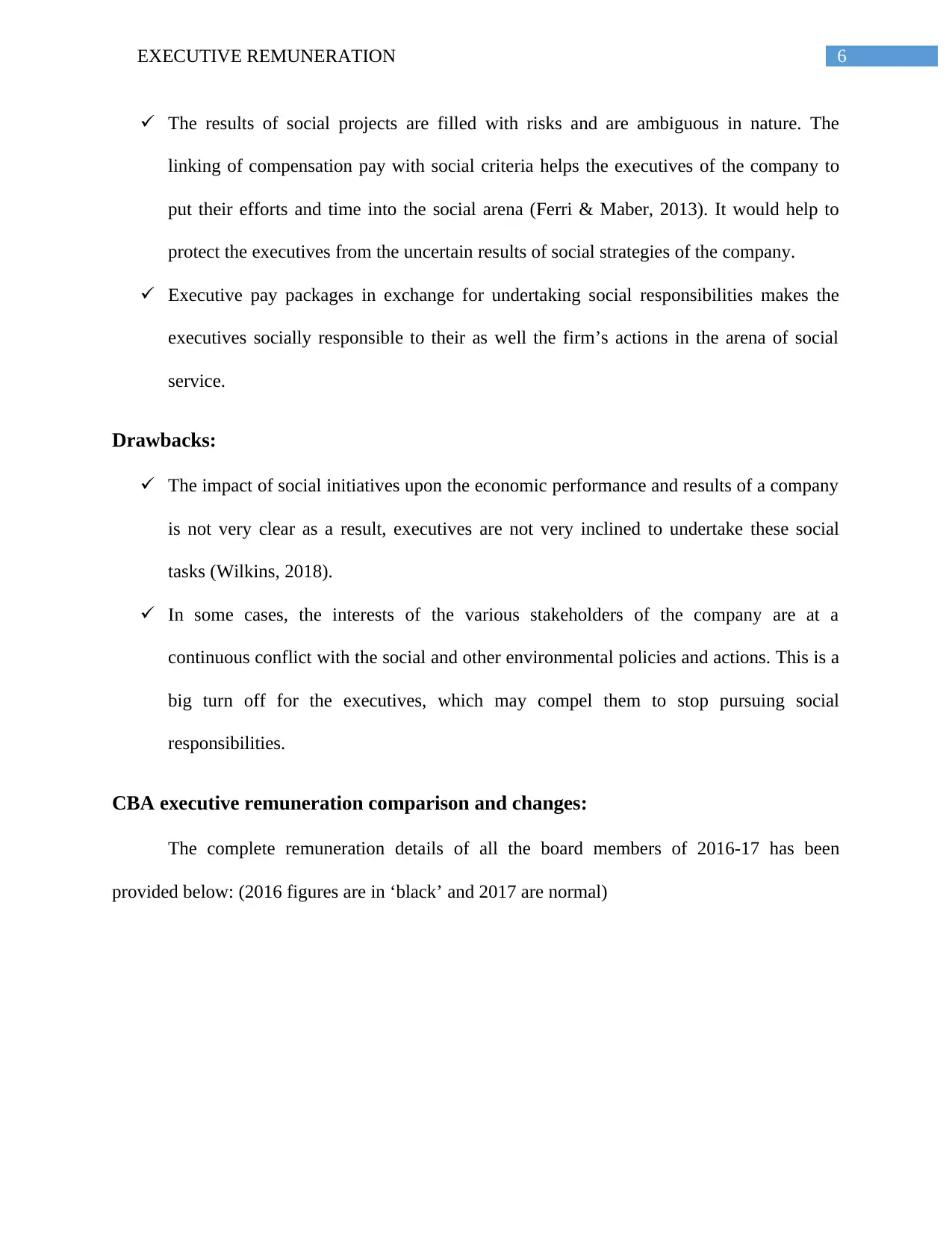
6EXECUTIVE REMUNERATION
The results of social projects are filled with risks and are ambiguous in nature. The
linking of compensation pay with social criteria helps the executives of the company to
put their efforts and time into the social arena (Ferri & Maber, 2013). It would help to
protect the executives from the uncertain results of social strategies of the company.
Executive pay packages in exchange for undertaking social responsibilities makes the
executives socially responsible to their as well the firm’s actions in the arena of social
service.
Drawbacks:
The impact of social initiatives upon the economic performance and results of a company
is not very clear as a result, executives are not very inclined to undertake these social
tasks (Wilkins, 2018).
In some cases, the interests of the various stakeholders of the company are at a
continuous conflict with the social and other environmental policies and actions. This is a
big turn off for the executives, which may compel them to stop pursuing social
responsibilities.
CBA executive remuneration comparison and changes:
The complete remuneration details of all the board members of 2016-17 has been
provided below: (2016 figures are in ‘black’ and 2017 are normal)
The results of social projects are filled with risks and are ambiguous in nature. The
linking of compensation pay with social criteria helps the executives of the company to
put their efforts and time into the social arena (Ferri & Maber, 2013). It would help to
protect the executives from the uncertain results of social strategies of the company.
Executive pay packages in exchange for undertaking social responsibilities makes the
executives socially responsible to their as well the firm’s actions in the arena of social
service.
Drawbacks:
The impact of social initiatives upon the economic performance and results of a company
is not very clear as a result, executives are not very inclined to undertake these social
tasks (Wilkins, 2018).
In some cases, the interests of the various stakeholders of the company are at a
continuous conflict with the social and other environmental policies and actions. This is a
big turn off for the executives, which may compel them to stop pursuing social
responsibilities.
CBA executive remuneration comparison and changes:
The complete remuneration details of all the board members of 2016-17 has been
provided below: (2016 figures are in ‘black’ and 2017 are normal)
Paraphrase This Document
Need a fresh take? Get an instant paraphrase of this document with our AI Paraphraser
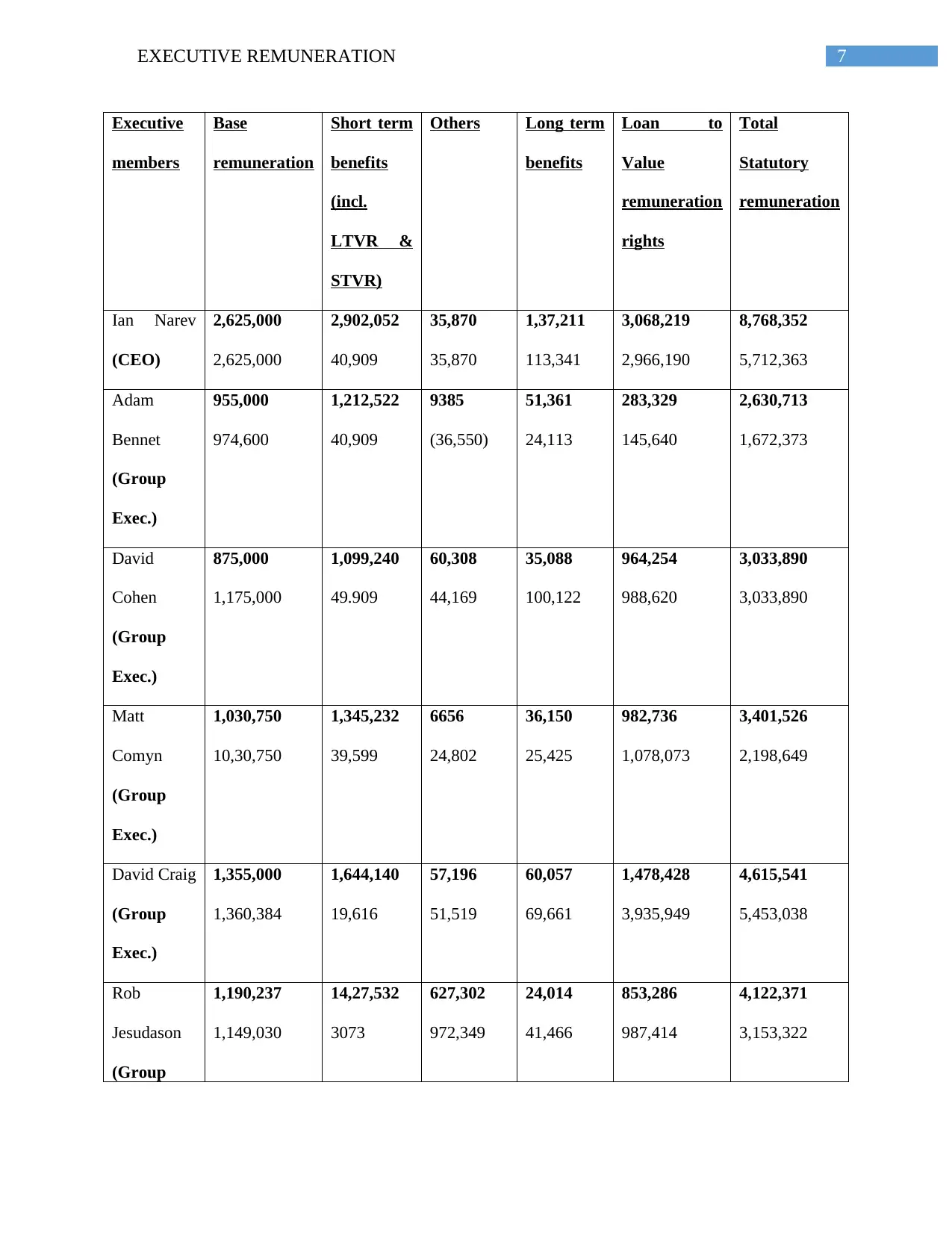
7EXECUTIVE REMUNERATION
Executive
members
Base
remuneration
Short term
benefits
(incl.
LTVR &
STVR)
Others Long term
benefits
Loan to
Value
remuneration
rights
Total
Statutory
remuneration
Ian Narev
(CEO)
2,625,000
2,625,000
2,902,052
40,909
35,870
35,870
1,37,211
113,341
3,068,219
2,966,190
8,768,352
5,712,363
Adam
Bennet
(Group
Exec.)
955,000
974,600
1,212,522
40,909
9385
(36,550)
51,361
24,113
283,329
145,640
2,630,713
1,672,373
David
Cohen
(Group
Exec.)
875,000
1,175,000
1,099,240
49.909
60,308
44,169
35,088
100,122
964,254
988,620
3,033,890
3,033,890
Matt
Comyn
(Group
Exec.)
1,030,750
10,30,750
1,345,232
39,599
6656
24,802
36,150
25,425
982,736
1,078,073
3,401,526
2,198,649
David Craig
(Group
Exec.)
1,355,000
1,360,384
1,644,140
19,616
57,196
51,519
60,057
69,661
1,478,428
3,935,949
4,615,541
5,453,038
Rob
Jesudason
(Group
1,190,237
1,149,030
14,27,532
3073
627,302
972,349
24,014
41,466
853,286
987,414
4,122,371
3,153,322
Executive
members
Base
remuneration
Short term
benefits
(incl.
LTVR &
STVR)
Others Long term
benefits
Loan to
Value
remuneration
rights
Total
Statutory
remuneration
Ian Narev
(CEO)
2,625,000
2,625,000
2,902,052
40,909
35,870
35,870
1,37,211
113,341
3,068,219
2,966,190
8,768,352
5,712,363
Adam
Bennet
(Group
Exec.)
955,000
974,600
1,212,522
40,909
9385
(36,550)
51,361
24,113
283,329
145,640
2,630,713
1,672,373
David
Cohen
(Group
Exec.)
875,000
1,175,000
1,099,240
49.909
60,308
44,169
35,088
100,122
964,254
988,620
3,033,890
3,033,890
Matt
Comyn
(Group
Exec.)
1,030,750
10,30,750
1,345,232
39,599
6656
24,802
36,150
25,425
982,736
1,078,073
3,401,526
2,198,649
David Craig
(Group
Exec.)
1,355,000
1,360,384
1,644,140
19,616
57,196
51,519
60,057
69,661
1,478,428
3,935,949
4,615,541
5,453,038
Rob
Jesudason
(Group
1,190,237
1,149,030
14,27,532
3073
627,302
972,349
24,014
41,466
853,286
987,414
4,122,371
3,153,322
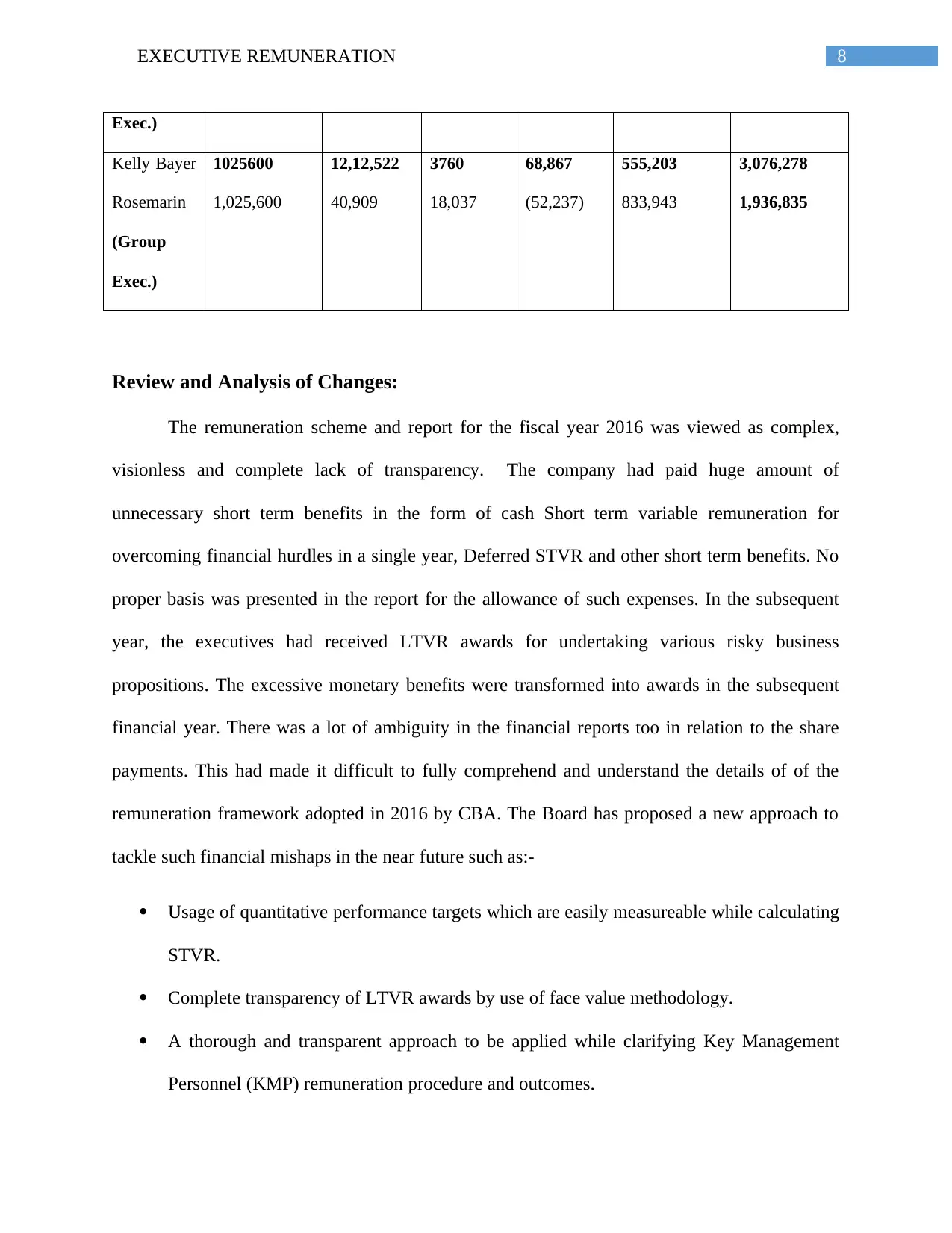
8EXECUTIVE REMUNERATION
Exec.)
Kelly Bayer
Rosemarin
(Group
Exec.)
1025600
1,025,600
12,12,522
40,909
3760
18,037
68,867
(52,237)
555,203
833,943
3,076,278
1,936,835
Review and Analysis of Changes:
The remuneration scheme and report for the fiscal year 2016 was viewed as complex,
visionless and complete lack of transparency. The company had paid huge amount of
unnecessary short term benefits in the form of cash Short term variable remuneration for
overcoming financial hurdles in a single year, Deferred STVR and other short term benefits. No
proper basis was presented in the report for the allowance of such expenses. In the subsequent
year, the executives had received LTVR awards for undertaking various risky business
propositions. The excessive monetary benefits were transformed into awards in the subsequent
financial year. There was a lot of ambiguity in the financial reports too in relation to the share
payments. This had made it difficult to fully comprehend and understand the details of of the
remuneration framework adopted in 2016 by CBA. The Board has proposed a new approach to
tackle such financial mishaps in the near future such as:-
Usage of quantitative performance targets which are easily measureable while calculating
STVR.
Complete transparency of LTVR awards by use of face value methodology.
A thorough and transparent approach to be applied while clarifying Key Management
Personnel (KMP) remuneration procedure and outcomes.
Exec.)
Kelly Bayer
Rosemarin
(Group
Exec.)
1025600
1,025,600
12,12,522
40,909
3760
18,037
68,867
(52,237)
555,203
833,943
3,076,278
1,936,835
Review and Analysis of Changes:
The remuneration scheme and report for the fiscal year 2016 was viewed as complex,
visionless and complete lack of transparency. The company had paid huge amount of
unnecessary short term benefits in the form of cash Short term variable remuneration for
overcoming financial hurdles in a single year, Deferred STVR and other short term benefits. No
proper basis was presented in the report for the allowance of such expenses. In the subsequent
year, the executives had received LTVR awards for undertaking various risky business
propositions. The excessive monetary benefits were transformed into awards in the subsequent
financial year. There was a lot of ambiguity in the financial reports too in relation to the share
payments. This had made it difficult to fully comprehend and understand the details of of the
remuneration framework adopted in 2016 by CBA. The Board has proposed a new approach to
tackle such financial mishaps in the near future such as:-
Usage of quantitative performance targets which are easily measureable while calculating
STVR.
Complete transparency of LTVR awards by use of face value methodology.
A thorough and transparent approach to be applied while clarifying Key Management
Personnel (KMP) remuneration procedure and outcomes.
⊘ This is a preview!⊘
Do you want full access?
Subscribe today to unlock all pages.

Trusted by 1+ million students worldwide
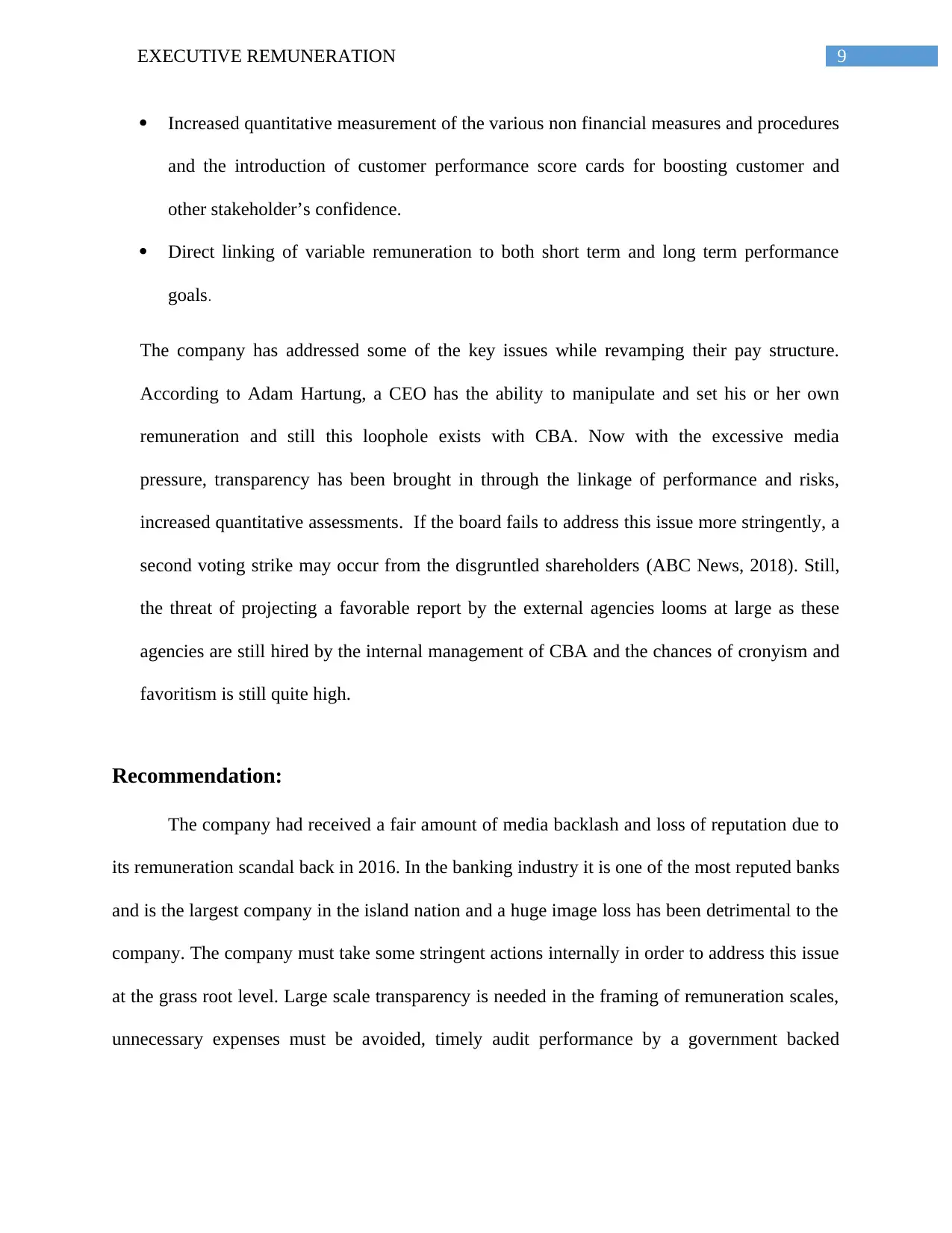
9EXECUTIVE REMUNERATION
Increased quantitative measurement of the various non financial measures and procedures
and the introduction of customer performance score cards for boosting customer and
other stakeholder’s confidence.
Direct linking of variable remuneration to both short term and long term performance
goals.
The company has addressed some of the key issues while revamping their pay structure.
According to Adam Hartung, a CEO has the ability to manipulate and set his or her own
remuneration and still this loophole exists with CBA. Now with the excessive media
pressure, transparency has been brought in through the linkage of performance and risks,
increased quantitative assessments. If the board fails to address this issue more stringently, a
second voting strike may occur from the disgruntled shareholders (ABC News, 2018). Still,
the threat of projecting a favorable report by the external agencies looms at large as these
agencies are still hired by the internal management of CBA and the chances of cronyism and
favoritism is still quite high.
Recommendation:
The company had received a fair amount of media backlash and loss of reputation due to
its remuneration scandal back in 2016. In the banking industry it is one of the most reputed banks
and is the largest company in the island nation and a huge image loss has been detrimental to the
company. The company must take some stringent actions internally in order to address this issue
at the grass root level. Large scale transparency is needed in the framing of remuneration scales,
unnecessary expenses must be avoided, timely audit performance by a government backed
Increased quantitative measurement of the various non financial measures and procedures
and the introduction of customer performance score cards for boosting customer and
other stakeholder’s confidence.
Direct linking of variable remuneration to both short term and long term performance
goals.
The company has addressed some of the key issues while revamping their pay structure.
According to Adam Hartung, a CEO has the ability to manipulate and set his or her own
remuneration and still this loophole exists with CBA. Now with the excessive media
pressure, transparency has been brought in through the linkage of performance and risks,
increased quantitative assessments. If the board fails to address this issue more stringently, a
second voting strike may occur from the disgruntled shareholders (ABC News, 2018). Still,
the threat of projecting a favorable report by the external agencies looms at large as these
agencies are still hired by the internal management of CBA and the chances of cronyism and
favoritism is still quite high.
Recommendation:
The company had received a fair amount of media backlash and loss of reputation due to
its remuneration scandal back in 2016. In the banking industry it is one of the most reputed banks
and is the largest company in the island nation and a huge image loss has been detrimental to the
company. The company must take some stringent actions internally in order to address this issue
at the grass root level. Large scale transparency is needed in the framing of remuneration scales,
unnecessary expenses must be avoided, timely audit performance by a government backed
Paraphrase This Document
Need a fresh take? Get an instant paraphrase of this document with our AI Paraphraser

10EXECUTIVE REMUNERATION
independent agency must be done in order to ensure complete authenticity in the pay process in
order to ensure an avoidance of similar incidents in the future.
independent agency must be done in order to ensure complete authenticity in the pay process in
order to ensure an avoidance of similar incidents in the future.
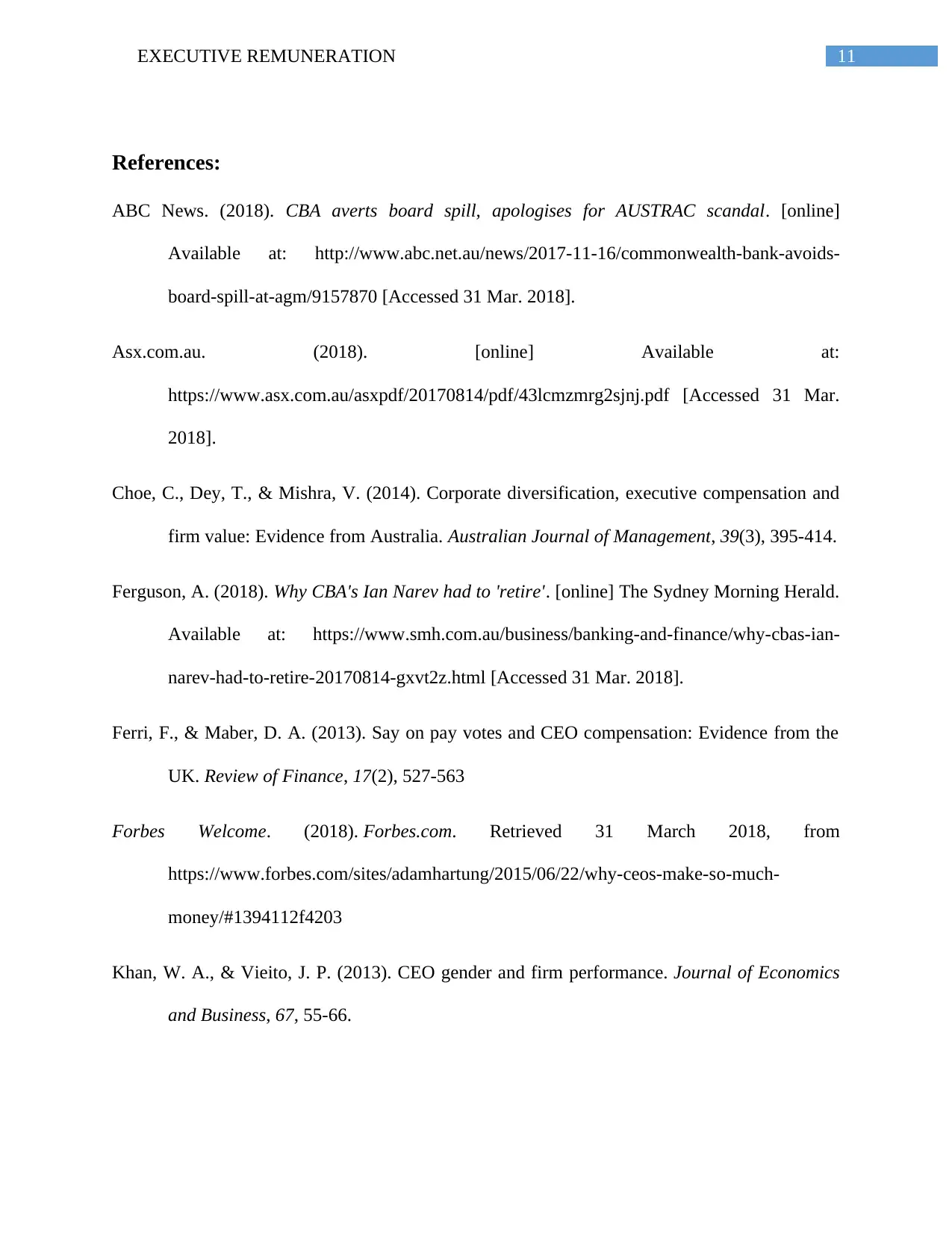
11EXECUTIVE REMUNERATION
References:
ABC News. (2018). CBA averts board spill, apologises for AUSTRAC scandal. [online]
Available at: http://www.abc.net.au/news/2017-11-16/commonwealth-bank-avoids-
board-spill-at-agm/9157870 [Accessed 31 Mar. 2018].
Asx.com.au. (2018). [online] Available at:
https://www.asx.com.au/asxpdf/20170814/pdf/43lcmzmrg2sjnj.pdf [Accessed 31 Mar.
2018].
Choe, C., Dey, T., & Mishra, V. (2014). Corporate diversification, executive compensation and
firm value: Evidence from Australia. Australian Journal of Management, 39(3), 395-414.
Ferguson, A. (2018). Why CBA's Ian Narev had to 'retire'. [online] The Sydney Morning Herald.
Available at: https://www.smh.com.au/business/banking-and-finance/why-cbas-ian-
narev-had-to-retire-20170814-gxvt2z.html [Accessed 31 Mar. 2018].
Ferri, F., & Maber, D. A. (2013). Say on pay votes and CEO compensation: Evidence from the
UK. Review of Finance, 17(2), 527-563
Forbes Welcome. (2018). Forbes.com. Retrieved 31 March 2018, from
https://www.forbes.com/sites/adamhartung/2015/06/22/why-ceos-make-so-much-
money/#1394112f4203
Khan, W. A., & Vieito, J. P. (2013). CEO gender and firm performance. Journal of Economics
and Business, 67, 55-66.
References:
ABC News. (2018). CBA averts board spill, apologises for AUSTRAC scandal. [online]
Available at: http://www.abc.net.au/news/2017-11-16/commonwealth-bank-avoids-
board-spill-at-agm/9157870 [Accessed 31 Mar. 2018].
Asx.com.au. (2018). [online] Available at:
https://www.asx.com.au/asxpdf/20170814/pdf/43lcmzmrg2sjnj.pdf [Accessed 31 Mar.
2018].
Choe, C., Dey, T., & Mishra, V. (2014). Corporate diversification, executive compensation and
firm value: Evidence from Australia. Australian Journal of Management, 39(3), 395-414.
Ferguson, A. (2018). Why CBA's Ian Narev had to 'retire'. [online] The Sydney Morning Herald.
Available at: https://www.smh.com.au/business/banking-and-finance/why-cbas-ian-
narev-had-to-retire-20170814-gxvt2z.html [Accessed 31 Mar. 2018].
Ferri, F., & Maber, D. A. (2013). Say on pay votes and CEO compensation: Evidence from the
UK. Review of Finance, 17(2), 527-563
Forbes Welcome. (2018). Forbes.com. Retrieved 31 March 2018, from
https://www.forbes.com/sites/adamhartung/2015/06/22/why-ceos-make-so-much-
money/#1394112f4203
Khan, W. A., & Vieito, J. P. (2013). CEO gender and firm performance. Journal of Economics
and Business, 67, 55-66.
⊘ This is a preview!⊘
Do you want full access?
Subscribe today to unlock all pages.

Trusted by 1+ million students worldwide
1 out of 13
Related Documents
Your All-in-One AI-Powered Toolkit for Academic Success.
+13062052269
info@desklib.com
Available 24*7 on WhatsApp / Email
![[object Object]](/_next/static/media/star-bottom.7253800d.svg)
Unlock your academic potential
Copyright © 2020–2025 A2Z Services. All Rights Reserved. Developed and managed by ZUCOL.





